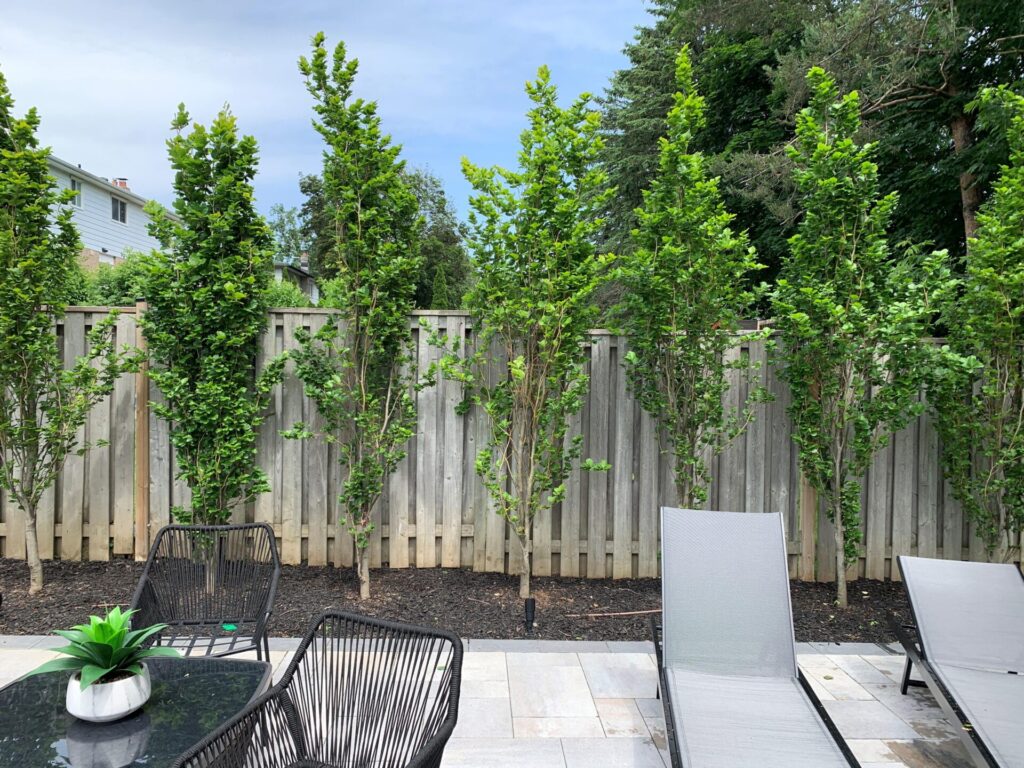
Q: Regarding my Dawyck Hold Beech Trees…
We planted 14 last year, 7 at the back of the property (50% sun) and 7 on the side (100% sun). The trees in the back are growing very well while a few of our beech trees (3 or 4) on the side are looking thin in the lower and middle sections? Our landscaper thinks it could be too much water however within the group of 7 on the side half of them look healthly which is confusing to me…Any thoughts? FYI We live in Markham, ON is that helps with any info..
Thank you for contacting the Toronto Master gardeners concerning your Dawyck Gold Beech tree.
You have chosen a very attractive tree for your privacy hedge. The leaves emerge gold in spring, and turn an attractive lime green in summer. The serrated pointy leaves are highly ornamental. They turn an outstanding coppery-bronze in the fall. The smooth silver bark is extremely showy and adds significant winter interest. However, unlike other beech trees which hold onto their leaves during the winter, termed “marcescent”, this variety of beech seems to be a variety of beech that drops its leaves in the fall.
The Dawyck Gold grows slowly, but it will reach a height of about 45 to 50 feet with a spread of only 10 to 15 feet. It is stated as being hardy to zone 6a. It should be noted that Markham’s hardiness zone ranges from zone 5a-6a. This tree grows best in full sun (6-8hrs) in average to evenly moist soil. The one thing the tree cannot tolerate is poorly draining soil. It is not fussy when it comes to type of soil or soil pH and will benefit from being planted in a relatively sheltered location.
There are a number of reasons why the 4 trees could be losing their leaves, one of which is too much water, as was suggested by your landscaper. Do you have an irrigation system? Do the trees in question receive more water than the other trees on either side? Is there something impeding drainage in the area of the 4 trees?
Proper watering is the key to success for newly planted trees. When you water, have the water run slowly for for a long period of time. If you run the water for at least an hour the water will be able to soak down into the roots. Let the soil dry out before you re-water. You may find you are watering less often but the trees will do better. Small amounts of water do not make it down to the roots — with evaporation, run off etc. competing for the water, very little water, if any, will make it to the roots.
Another issue could be the way the trees were planted. In general, when a tree is newly planted, the root flare/root collar, (the place where the roots meet the trunk) should be set in the ground so that the soil grade is level with the bottom of the root collar. When planted at the proper level you will see the gentle flare of the trunk rise just above the soil line. It is better to err on the side of placing the tree higher above the soil, especially if you suspect the soil will settle, or the site is not well drained..
It is difficult to see from your photo if the root flare is visible in the trees in question. Toronto Master Gardeners has an excellent guide on Planting a Tree for Life which may be of interest.
Our suggestion would be to first check if uneven watering is an issue: too much or too little. Place containers throughout the garden bed, and check the amount of water collected at different locations. Check drainage to make sure there is equal drainage across the entire bed. Lastly, pull back some mulch and make sure the root flare is just above the soil level.
Good Luck with your Dawyck Gold beech trees.

